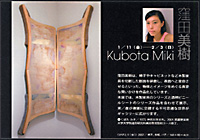 |
Picks is a monthly sampling of Japan's art scene, offering short reviews of exhibitions at museums and galleries in recent weeks, with an emphasis on contemporary art by young artists. |
 |
 |
|
|
 |
 |
| Katsushika Hokusai: Siebold & Hokusai and his Tradition |
| 4 December 2007 - 27 January 2008 |
Edo-Tokyo Museum
(Tokyo) |
 |
| Born in 1760, renowned ukiyo-e master Hokusai was the first Japanese artist to familiarize himself with Western art techniques. Earning him a following not only in Japan but also in Europe, his depictions of everyday life in Edo hang in places like the Bibliotheque Nationale de France and the National Museum of Ethnology in Leyden, the Netherlands, which loaned the works seen in this exhibit. |
|
|
 |
 |
 |
| Takashi Ishida: Wall of the Sea |
| 12 - 31 January 2008 |
galerie 16
(Kyoto) |
 |
| Ishida started out as a painter, went through a phase as a painting performance artist, and since 1995 has been creating video works. He has developed an individual style of "drawing animation" to create literally moving pictures using multiple panels of paintings composed of organic lines. The works in this show vividly express the surge and roar of ocean waves. |
|
|
|
|

|
 |
 |
 |
|
Atsushi Suwa: Realist with compound eyes |
| 17 January - 24 February 2008 |
Sato Museum of Art
(Tokyo) |
 |
| Born in Hokkaido, Suwa attended art school in Tokyo, then spent two years in Madrid, where he won the grand prize in an international art competition. Returning to Japan, he continued to paint Realist works but later shifted to a style of production that addresses the process of communication with his subjects. |
|
|
 |
 |
|
| Miki Kubota |
| 11 January - 3 February 2008 |
Shiseido Gallery
(Tokyo)
| Kubota creates sculptures by slicing up chairs, cabinets and other wooden pieces of furniture and reconstructing them into new forms. Part of Shiseido's second annual Art Egg series introducing young artists, this show also features works consisting of clear vinyl sheets on which images have been applied with adhesive. |
|
|
|
|
|
|
|

|
 |
 |
 |
 |
| Noe Aoki |
| 18 January - 9 February 2008 |
space 355
(Tokyo) |
 |
| Sculptor and print artist Aoki has won numerous prizes. Her iron sculptures often exceed two meters in height, yet do not seem heavy, interacting freely with the surrounding light and space. In 1997 she began making copper prints, followed later by a series of colorful woodblock works. |
|
|
 |
 |
| Mitsuko Tabe |
| 14 - 26 January 2008 |
Gallery-58
(Tokyo) |
 |
| Painter Tabe was born in Taiwan in 1933; from 1953 to 1970 she was a core member of the avant-garde art group Kyushu-ha. Since 1963 a recurring motif in her work has been apples. Tabe declares that Cezanne was similarly obsessed with painting apples, even if his landscapes and portraits proved more successful; by continuing to paint these symbols of knowledge and feminism, she seeks to resolve the questions posed by Cezanne's apples. |
|

|
 |
 |
 |
  |
|
| Reiko Tamura |
| 21 - 26 January 2008 |
Gallery Yamaguchi
(Tokyo) |
 |
| Tamura began by exhibiting drawings, then quit to study interior design and became an architect. She resumed her artistic career in 1999 with a series of woodblock prints, then switched to photography in 2003. She says that she looks for unfamiliar images from her subconscious in actual landscapes of familiar places. |
|
|
|
|
 |
 |
 |
| Riki Kato: Piece of Peace |
| 21 January - 2 February 2008 |
Gallery Yamaguchi
(Tokyo) |
 |
| A native Tokyoite, Kato has shown his works in numerous shows since studying oil painting at Tokyo University of the Arts. Besides museums and galleries, he likes to exhibit on streets, in shops and homes, and conducts workshops for children and art therapy classes for the cognitively impaired. In this show he reexamines the items for sale in 100 yen shops, highlighting the ambiguity of human values. |
|
|
|
|
|
|
 |
 |
| Yokoyama Taikan: Fifty Years On -- A legend in the making |
| 23 January - 3 March 2008 |
National Art Center, Tokyo
(Tokyo) |
 |
| The undisputed master of modern Nihonga, Taikan (1868-1958) was part of the first class to graduate from Tokyo School of the Arts and was active well into the postwar era. Studying the Japanese painting traditions of Rinpa, Yamato-e, and sumi-e, he created his own style of Nihonga and left a vast oeuvre of masterpieces. This major retrospective commemorates the 50th anniversary of his death and includes works loaned from overseas. |
|
 |
 |
 |
| Mai Ueura and Chihiro Habe: Memory and an Ideal View |
| 21 - 26 January 2008 |
O Gallery eyes
(Osaka) |
 |
| Born in 1980 and 1982 respectively, Ueura and Habe grew up and studied art in the Kansai district and have exhibited frequently there. Whereas Habe paints landscapes using everyday motifs, Ueura uses a bright color palette to paint scenes that seem inspired by picture books. Both are adept at creating a sense of story and place. |
|
|
|
|
 |
|